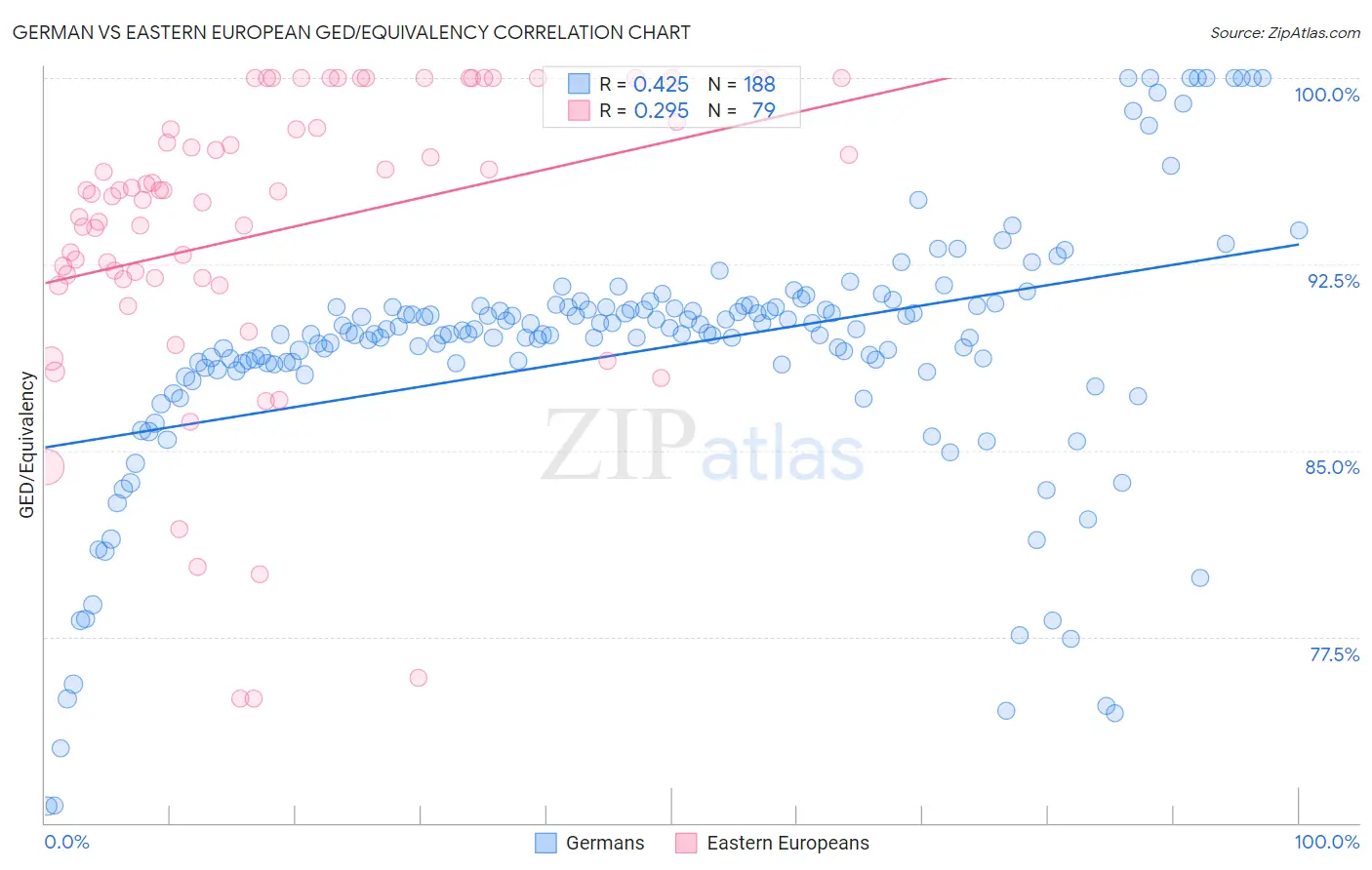German vs Eastern European GED/Equivalency
COMPARE
German
Eastern European
GED/Equivalency
GED/Equivalency Comparison
Germans
Eastern Europeans
87.9%
GED/EQUIVALENCY
99.3/ 100
METRIC RATING
62nd/ 347
METRIC RANK
89.1%
GED/EQUIVALENCY
99.9/ 100
METRIC RATING
7th/ 347
METRIC RANK
German vs Eastern European GED/Equivalency Correlation Chart
The statistical analysis conducted on geographies consisting of 581,300,690 people shows a moderate positive correlation between the proportion of Germans and percentage of population with at least ged/equivalency education in the United States with a correlation coefficient (R) of 0.425 and weighted average of 87.9%. Similarly, the statistical analysis conducted on geographies consisting of 461,247,198 people shows a weak positive correlation between the proportion of Eastern Europeans and percentage of population with at least ged/equivalency education in the United States with a correlation coefficient (R) of 0.295 and weighted average of 89.1%, a difference of 1.4%.

GED/Equivalency Correlation Summary
| Measurement | German | Eastern European |
| Minimum | 70.7% | 75.0% |
| Maximum | 100.0% | 100.0% |
| Range | 29.3% | 25.0% |
| Mean | 89.0% | 93.8% |
| Median | 89.7% | 95.3% |
| Interquartile 25% (IQ1) | 88.4% | 91.9% |
| Interquartile 75% (IQ3) | 90.8% | 98.0% |
| Interquartile Range (IQR) | 2.4% | 6.1% |
| Standard Deviation (Sample) | 5.3% | 6.1% |
| Standard Deviation (Population) | 5.3% | 6.0% |
Similar Demographics by GED/Equivalency
Demographics Similar to Germans by GED/Equivalency
In terms of ged/equivalency, the demographic groups most similar to Germans are Immigrants from Turkey (87.9%, a difference of 0.010%), Scandinavian (87.9%, a difference of 0.020%), European (87.9%, a difference of 0.020%), Serbian (87.9%, a difference of 0.030%), and Immigrants from Czechoslovakia (87.9%, a difference of 0.040%).
| Demographics | Rating | Rank | GED/Equivalency |
| New Zealanders | 99.4 /100 | #55 | Exceptional 88.0% |
| Immigrants | Denmark | 99.4 /100 | #56 | Exceptional 88.0% |
| Immigrants | Czechoslovakia | 99.3 /100 | #57 | Exceptional 87.9% |
| Northern Europeans | 99.3 /100 | #58 | Exceptional 87.9% |
| Serbians | 99.3 /100 | #59 | Exceptional 87.9% |
| Scandinavians | 99.3 /100 | #60 | Exceptional 87.9% |
| Europeans | 99.3 /100 | #61 | Exceptional 87.9% |
| Germans | 99.3 /100 | #62 | Exceptional 87.9% |
| Immigrants | Turkey | 99.2 /100 | #63 | Exceptional 87.9% |
| Immigrants | Canada | 99.2 /100 | #64 | Exceptional 87.9% |
| Immigrants | North America | 99.1 /100 | #65 | Exceptional 87.8% |
| Immigrants | Bulgaria | 99.1 /100 | #66 | Exceptional 87.8% |
| British | 99.1 /100 | #67 | Exceptional 87.8% |
| Immigrants | France | 99.1 /100 | #68 | Exceptional 87.8% |
| Immigrants | Saudi Arabia | 99.0 /100 | #69 | Exceptional 87.8% |
Demographics Similar to Eastern Europeans by GED/Equivalency
In terms of ged/equivalency, the demographic groups most similar to Eastern Europeans are Thai (89.1%, a difference of 0.040%), Carpatho Rusyn (89.1%, a difference of 0.050%), Latvian (89.2%, a difference of 0.060%), Chinese (89.0%, a difference of 0.070%), and Norwegian (89.0%, a difference of 0.12%).
| Demographics | Rating | Rank | GED/Equivalency |
| Immigrants | India | 100.0 /100 | #1 | Exceptional 89.7% |
| Filipinos | 100.0 /100 | #2 | Exceptional 89.5% |
| Immigrants | Singapore | 100.0 /100 | #3 | Exceptional 89.3% |
| Iranians | 100.0 /100 | #4 | Exceptional 89.2% |
| Latvians | 100.0 /100 | #5 | Exceptional 89.2% |
| Thais | 100.0 /100 | #6 | Exceptional 89.1% |
| Eastern Europeans | 99.9 /100 | #7 | Exceptional 89.1% |
| Carpatho Rusyns | 99.9 /100 | #8 | Exceptional 89.1% |
| Chinese | 99.9 /100 | #9 | Exceptional 89.0% |
| Norwegians | 99.9 /100 | #10 | Exceptional 89.0% |
| Bulgarians | 99.9 /100 | #11 | Exceptional 89.0% |
| Lithuanians | 99.9 /100 | #12 | Exceptional 88.9% |
| Immigrants | Iran | 99.9 /100 | #13 | Exceptional 88.9% |
| Cypriots | 99.9 /100 | #14 | Exceptional 88.9% |
| Okinawans | 99.9 /100 | #15 | Exceptional 88.9% |